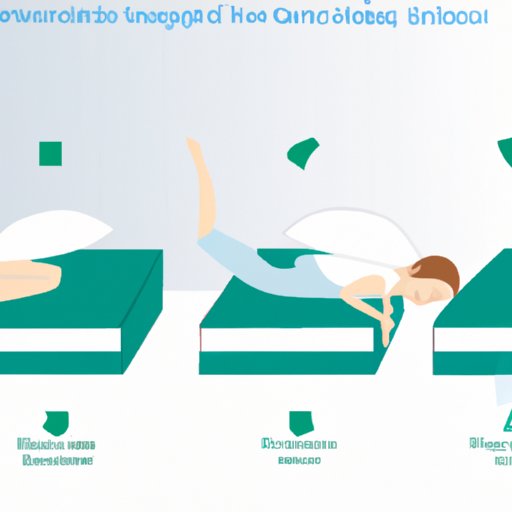
I. Introduction
If you’ve ever experienced sciatica, you know just how debilitating the pain can be. While it’s important to address the underlying causes, getting a good night’s sleep is crucial for managing sciatic pain and ensuring a quicker recovery. In this article, we’ll explore various tips and tricks for sleeping with sciatica, covering everything from ideal sleeping positions to medication recommendations.
II. Sleeping Positions
Sleeping on the right position is crucial for sciatica sufferers. One of the best positions is on your side with a pillow between your legs. This position helps reduce pressure on the lower back and hips, minimizing pain and discomfort. It is essential to choose a memory foam pillow as it fills the gaps between knees and provides necessary support to keep your back correctly aligned.
Other alternative sleeping positions recommended for sciatica sufferers include sleeping on the back with a pillow under the knees or sleeping in a reclined position.
It is also crucial to get comfortable in bed and to try not to twist your spine when getting in or out of bed, which can cause further discomfort, especially during a flare-up. You can also try arranging pillows to support your neck, back, and legs.
III. Mattress and Pillow Selection
The right mattress and pillow can make a significant difference in the quality of sleep for people living with sciatica. It is necessary to choose a mattress that offers the right level of firmness and support required for people with sciatica. Mattress with medium firmness is ideal for sciatica sufferers as it provides the necessary support to the pressure points and aligns the spine in the right position.
The recommended pillows for people with sciatica are memory foam pillows or pillows made up of latex, as they provide adequate support and align the spine to reduce strain on the back while sleeping. If you tend to sleep on your back, flat pillows are preferable, while contour or wedge pillows are ideal for side sleepers.
Other tips to enhance your sleeping environment include keeping your mattress and pillows clean, allowing fresh air to circulate in the bedroom, and ensuring a cool and dark environment to minimize disruptions.
IV. Exercise and Stretching
Exercise and stretching can be significantly beneficial in managing sciatic pain. Working with a physical therapist or a specialized trainer can help tailor exercises that work best for your needs and level of fitness. The primary focus of exercises should be on flexibility, strengthening, and improving posture.
Possible exercises that may help alleviate sciatic pain include low-impact activities like walking, swimming, and cycling. Additionally, yoga stretches and core strengthening exercises can help support the spine and reduce pressure on the lower back. However, it’s critical to avoid high-impact exercises that may worsen the condition, like running or jumping.
A physical therapist can guide you through the correct techniques and ensure that you don’t push yourself too hard. Overexertion can strain the muscles and ligaments, leading to increased pain and discomfort.
V. Heat Therapy
Heat therapy can help relieve the pain and stiffness associated with sciatica. Applying a heating pad or hot water bottle to the areas of discomfort can help promote circulation and relax tense muscles.
The heat therapy should be applied for 15 to 20 minutes at a time, and it’s important to avoid applying heat directly to the skin to prevent burns. It’s also important to be cautious when using heat therapy, especially if you have a pre-existing medical condition like diabetes or blood circulation issues.
VI. Medications
Over-the-counter medications like nonsteroidal anti-inflammatory drugs (NSAIDs) or acetaminophen can help reduce inflammation and relieve pain associated with sciatica. It is essential to consult with a doctor before starting any medication as some can have serious side effects that affect your overall health.
Other medications like muscle relaxants or opioids are typically prescribed for severe or chronic cases of sciatic pain. Opioids, however, should be taken with caution due to their addictiveness and potential side effects. It’s crucial to strictly follow the instructions provided by your doctor regarding medication dosage and use.
VII. Create a Bedtime Routine
Establishing a regular sleep routine can help improve the quality of sleep for sciatica sufferers. It’s essential to create a consistent schedule and stick to it, even on the weekends. A regular sleep routine can help regulate the body’s internal clock and help promote better sleep patterns.
It’s also vital to incorporate relaxation activities into the bedtime routine, such as reading, taking a warm bath, or practicing meditation or deep breathing exercises. These activities can help calm the mind and reduce stress, allowing for a more restful and comfortable sleep.
VIII. Addressing Underlying Causes
Sciatica is often caused by underlying conditions such as herniated discs or spinal stenosis, which require professional medical attention. It’s important to seek help from a doctor or specialist to diagnose and treat the underlying condition effectively.
It is also crucial to maintain overall good health and wellbeing by eating a balanced diet, staying hydrated, and engaging in regular physical activity. These lifestyle changes can help maintain a healthy weight, reduce stress, and improve overall health, reducing the likelihood of sciatic pain.
IX. Conclusion
Sleeping with sciatica can be a challenge, but implementing certain tips and tricks can improve the quality of sleep significantly. From ideal sleeping positions and pillow and mattress selection to exercise, heat therapy, medication, and establishing a bedtime routine, there are various methods to help manage sciatica symptoms. It’s essential to seek help from a doctor or specialist to address any underlying causes and maintain good health. By prioritizing restful sleep and following these tips, sciatica sufferers can enjoy a better quality of life.




